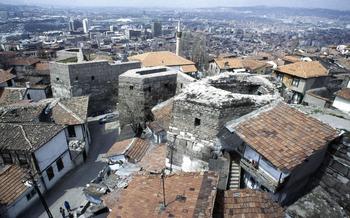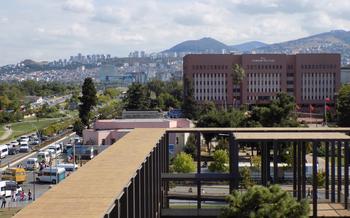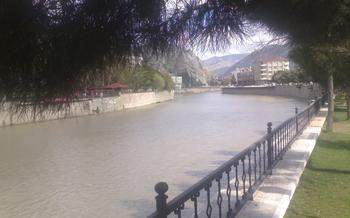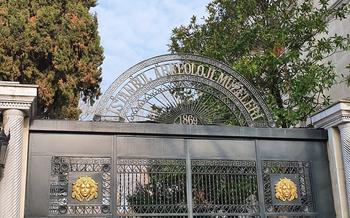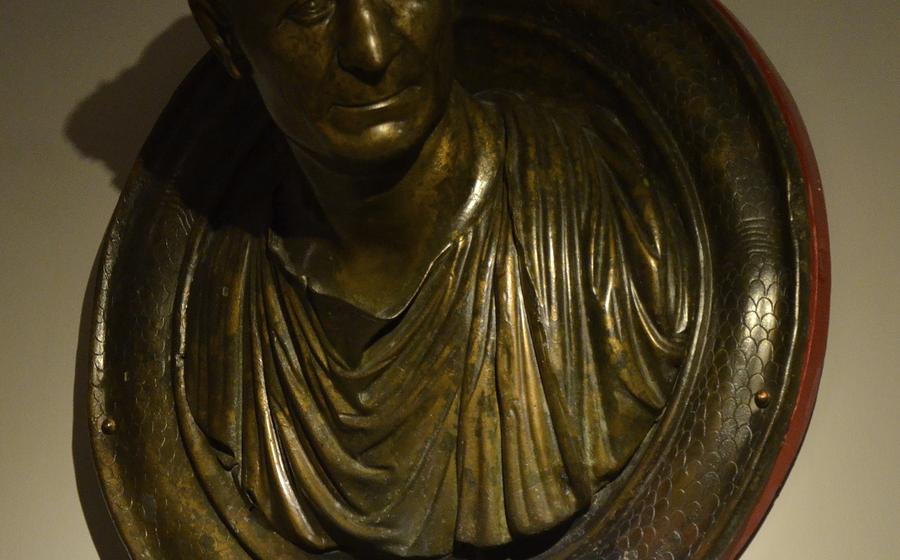
Museum of Anatolian Civilizations
- The Antiquity of Ankara
- The Roman and Byzantine Era
- The Seljuk and Ottoman Periods
- The Turkish Republic and Modern Ankara:
- Museum of Anatolian Civilizations
- The Hittite Collection
- The Phrygian Collection
- The Lydian Collection
- The Hellenistic and Roman Collections:
- The Byzantine and Early Christian Collections
- The Seljuk and Ottoman Collections
- Temporary Exhibitions and Programs
- Insider Tip
The Antiquity of Ankara
The ancient city of Ankara, once known as Ancyra, has a rich and storied history that dates back to the Bronze Age. Its strategic location at the crossroads of major trade routes made it a coveted prize for many civilizations throughout the ages. The Hittites, one of the most powerful empires of the ancient world, established their presence in the region around 2000 BC, leaving behind impressive remnants of their rule, including cuneiform tablets and rock carvings.
The Phrygians, another influential civilization, succeeded the Hittites and made Ankara their capital in the 8th century BC. Their legacy includes the Midas Mound, a tumulus believed to be the burial site of King Midas, renowned for his "golden touch."
The arrival of Alexander the Great in 333 BC marked a turning point in Ankara's history. The city fell under Hellenistic rule, leading to the introduction of Greek culture and architecture. The Temple of Augustus and Rome, built during this period, stands as a testament to the city's transformation into a major center of the Hellenistic world.
The Roman and Byzantine Era
During the Roman period, Ankara flourished as a major trade center, strategically located on the trade routes connecting the East and the West. The city's importance is evident in the construction of the Temple of Augustus and Rome, dedicated to the Roman emperor Augustus and the goddess Roma. This grand temple served as a symbol of Roman authority and the city's loyalty to the empire.
With the spread of Christianity, Ankara became a significant center for early Christian communities. Several churches were built during this period, including the Church of St. Clement, which still stands today as a testament to the city's rich religious heritage. The Byzantine Empire, which succeeded the Roman Empire, further solidified Ankara's role as a strategic stronghold. The city's fortifications were strengthened, and it became a key defensive outpost against invading forces.
The Seljuk and Ottoman Periods
In the 11th century, the Seljuk Turks, a nomadic people from Central Asia, conquered Ankara and made it their capital. The Seljuks were skilled builders and left behind a rich architectural legacy, including the Alaeddin Mosque, which is one of the oldest mosques in Ankara. The mosque is notable for its intricate stone carvings and its beautiful blue tiles.
In the 14th century, the Ottoman Turks, another nomadic people from Central Asia, conquered Ankara and made it a provincial center. The Ottomans ruled Ankara for over 500 years and during their time, the city grew in size and importance. The Ottomans built many new buildings in Ankara, including mosques, bathhouses, and caravanserais. They also improved the city's infrastructure, including by building new roads and bridges.
Ankara remained a provincial center under Ottoman rule until the early 20th century. In 1923, the Turkish Republic was founded and Ankara was designated as the capital. The city has since grown into a modern metropolis and is now home to over 5 million people.
The Turkish Republic and Modern Ankara:
In 1923, Ankara's destiny took a momentous turn when it was designated as the capital of the newly established Turkish Republic by Mustafa Kemal Atatürk, the revered founder and first president of the nation. This decision was driven by Ankara's strategic location in the heart of Anatolia and its distance from the turmoil of the coastal regions. Atatürk envisioned Ankara as a symbol of the Turkish nation's rebirth and a beacon of modernity.
Under Atatürk's leadership, Ankara underwent a remarkable transformation. Wide boulevards were laid out, imposing government buildings were constructed, and iconic landmarks such as the Anıtkabir, the mausoleum of Atatürk, were erected. The city became a vibrant hub of politics, culture, and education, attracting intellectuals, artists, and students from across the country.
Today, Ankara stands as a testament to the vision and determination of its founding father. It is a modern metropolis that seamlessly blends its rich history with the dynamism of a thriving capital city. Ankara's museums, theaters, universities, and vibrant cultural scene make it a must-visit destination for anyone seeking to understand the heart and soul of modern Turkey.
Museum of Anatolian Civilizations
Established in 1921, the Museum of Anatolian Civilizations proudly stands as a testament to the region's rich and diverse cultural heritage. This remarkable institution serves as a guardian of countless artifacts, spanning various civilizations that have left an indelible mark on the tapestry of Anatolia. The museum's collection is a treasure trove of historical wonders, narrating the tales of ancient empires, forgotten kingdoms, and vibrant cultures that once thrived in this land.
The architectural design of the museum itself is a testament to its historical significance. Housed in a former caravanserai, the museum's intricate stonework and arched entrances evoke the spirit of the Silk Road, where merchants and travelers from distant lands converged to exchange goods and ideas. The carefully curated layout of the exhibition halls guides visitors on a journey through time, showcasing the evolution of Anatolian civilizations from the prehistoric era to the present day.
Through its dedication to preserving and showcasing Anatolian heritage, the Museum of Anatolian Civilizations stands as a beacon of cultural enlightenment. With its vast collection, immersive exhibits, and educational programs, this institution plays a pivotal role in fostering a deeper understanding of the region's rich history and diverse cultural tapestry.
The Hittite Collection
The Museum of Anatolian Civilizations boasts an impressive collection of Hittite artifacts that are sure to captivate any visitor with an interest in ancient history. Among the most notable pieces are the cuneiform tablets, which provide valuable insights into the Hittite language, culture, and history. These tablets, inscribed with intricate symbols, offer a window into the lives of this powerful empire that once ruled over much of Anatolia.
The Hittites, who flourished in the 2nd millennium BC, left behind a rich legacy of art and architecture. Their distinctive style, characterized by intricate reliefs and monumental sculptures, can be seen in the impressive collection of artifacts on display at the museum. From imposing stone statues to delicate jewelry, each piece showcases the exceptional craftsmanship and artistic prowess of the Hittite civilization.
Of particular significance is the collection of Hittite seals, which bear intricate designs and symbols that served as emblems of authority and identity. These seals, often made of precious stones or metals, provide a glimpse into the Hittite administrative system and their sophisticated use of bureaucracy.
The Hittite collection at the Museum of Anatolian Civilizations is a testament to the rich cultural heritage of this ancient civilization. By exploring these artifacts, visitors can gain a deeper understanding of the Hittites' contributions to Anatolian history and their enduring influence on the region's cultural landscape.
The Phrygian Collection
The Museum of Anatolian Civilizations boasts a significant collection of Phrygian artifacts, including the renowned Midas Treasure. Discovered in the ancient Phrygian capital of Gordion, this treasure trove of gold jewelry, intricate metalwork, and ceremonial objects offers a glimpse into the opulence and artistry of this influential civilization.
The Phrygians, who ruled central Anatolia from the 12th to 7th centuries BC, were known for their advanced metalworking skills and distinctive artistic style. Their artifacts, often adorned with elaborate geometric patterns and animal motifs, reflect a blend of Eastern and Western influences.
Among the highlights of the Phrygian collection is the golden pectoral, a large chest ornament adorned with a winged solar disk and mythical creatures. The intricate filigree work and use of semi-precious stones demonstrate the exceptional craftsmanship of Phrygian artisans.
Another notable artifact is the Midas Treasure, named after the legendary Phrygian king Midas. The treasure includes a gold crown, bracelets, and other jewelry pieces, all exquisitely crafted and adorned with intricate designs. The discovery of the Midas Treasure has shed new light on the wealth and power of the Phrygian kingdom.
The Phrygian collection at the Museum of Anatolian Civilizations is a testament to the rich cultural heritage of this ancient civilization. Through these artifacts, visitors can gain insights into the history, artistry, and legacy of the Phrygians, who played a significant role in shaping the cultural landscape of Anatolia.
The Lydian Collection
The Museum of Anatolian Civilizations also houses a significant collection of Lydian artifacts, offering a glimpse into the history and culture of this ancient civilization. Among the most notable pieces are the gold coins and jewelry, renowned for their intricate craftsmanship and exquisite designs. These artifacts attest to the wealth and economic prowess of the Lydian kingdom, which played a crucial role in trade and commerce throughout the region.
The Lydians were known for their innovative monetary system, introducing the world's first standardized gold and silver coins. These coins, bearing the image of a lion, became widely accepted throughout the Mediterranean and beyond, facilitating trade and commerce. The Lydian collection at the museum showcases a variety of these coins, providing insights into the economic and financial systems of the ancient world.
In addition to coins, the Lydian collection includes an array of gold jewelry, adorned with intricate patterns and symbolic motifs. These pieces, crafted with exceptional skill and artistry, demonstrate the Lydians' mastery of metalworking techniques. Bracelets, necklaces, earrings, and rings, often featuring intricate filigree work and precious gemstones, showcase the Lydians' love of ornamentation and luxury.
The Lydian collection at the Museum of Anatolian Civilizations is essential for understanding the economic and cultural influence of this ancient kingdom. Through these artifacts, visitors can gain insights into the Lydians' innovative monetary system, their skilled craftsmanship, and their lavish lifestyle, which left a lasting legacy on the region and beyond.
The Hellenistic and Roman Collections:
The Museum of Anatolian Civilizations boasts an impressive collection of Hellenistic and Roman artifacts, reflecting the region's rich cultural exchange and artistic fusion during these periods. The influence of Greek and Roman mythology and iconography is evident in the exquisite sculptures, mosaics, and other objects on display. The Hellenistic period, characterized by the spread of Greek culture following Alexander the Great's conquests, left a significant mark on Anatolia. Sculptures depicting gods and goddesses, as well as intricate mosaics showcasing mythological scenes, provide a glimpse into the region's Hellenistic heritage.
The Roman era brought further cultural influences, as Anatolia became an integral part of the Roman Empire. Statues of Roman emperors, architectural fragments from Roman temples and theaters, and finely crafted mosaics depicting scenes from Roman life offer a testament to the region's Roman legacy. The Hellenistic and Roman collections at the Museum of Anatolian Civilizations offer valuable insights into the cultural and artistic interactions that shaped Anatolia during these significant periods of history.
The Byzantine and Early Christian Collections
The Museum of Anatolian Civilizations houses a significant collection of Byzantine and Early Christian artifacts, providing insights into the region's rich religious history. These artifacts showcase the artistic and cultural exchange that occurred during the Byzantine Empire's rule over Anatolia.
Among the highlights of the collection are exquisite icons, with their distinctive gold backgrounds and intricate depictions of religious figures. These icons offer a glimpse into the Byzantine tradition of iconography, which played a crucial role in the development of Eastern Christian art.
The museum also features a collection of well-preserved mosaics, which adorned the floors and walls of Byzantine churches. These mosaics depict biblical scenes, historical events, and everyday life, offering a vibrant glimpse into the visual culture of the period.
The Byzantine and Early Christian collections at the Museum of Anatolian Civilizations are a testament to the region's rich religious heritage. These artifacts provide valuable insights into the beliefs, practices, and artistic expressions of the Byzantine and Early Christian communities that once thrived in Anatolia.
The Seljuk and Ottoman Collections
The Museum of Anatolian Civilizations proudly houses an impressive collection of artifacts from the Seljuk and Ottoman periods, providing a glimpse into the rich Islamic heritage of Anatolia. The Seljuk Turks, renowned for their architectural prowess, left a lasting legacy in Ankara with the Alaeddin Mosque. The museum showcases intricate ceramics, manuscripts, and decorative arts that exemplify the Seljuk style, characterized by geometric patterns, floral motifs, and elegant calligraphy. The Ottoman Empire, which ruled Anatolia for over six centuries, contributed significantly to the region's artistic and cultural development. The museum's collection includes Ottoman tiles, textiles, metalwork, and illuminated manuscripts, showcasing the empire's mastery of Islamic art and craftsmanship. These artifacts tell the story of a diverse and vibrant society that blended Islamic traditions with local Anatolian influences, creating a unique cultural tapestry.
Temporary Exhibitions and Programs
The Museum of Anatolian Civilizations is not just a repository of ancient artifacts; it's also a vibrant hub for cultural exchange and learning. The museum regularly hosts temporary exhibitions that showcase diverse themes and artists, providing visitors with a glimpse into contemporary art and cultural expressions. These exhibitions often focus on specific periods, regions, or artistic movements, offering a fresh perspective on Anatolian history and culture.
In addition to temporary exhibitions, the museum organizes a range of educational programs, workshops, and lectures. These events are designed to engage visitors of all ages and provide a deeper understanding of Anatolian heritage. From hands-on workshops for children to in-depth lectures by renowned scholars, the museum's educational offerings cater to a wide range of interests and knowledge levels.
The museum's commitment to promoting cultural understanding and engagement extends beyond its walls. Through partnerships with educational institutions and cultural organizations, the museum collaborates on initiatives that foster intercultural dialogue and promote the appreciation of Anatolian heritage.
To make the most of your visit, be sure to check the museum's website for upcoming events and programs. The museum's calendar is regularly updated with information on temporary exhibitions, educational activities, and special events, ensuring that there's always something new to discover and explore.
Insider Tip
For an unforgettable experience, make your way to the museum's rooftop terrace, where you'll be rewarded with breathtaking panoramic views of Ankara, a city steeped in history and adorned with architectural wonders. Capture the essence of the city as you gaze upon its landmarks, including the iconic Kocatepe Mosque and the imposing Ankara Castle.
To fully immerse yourself in the museum's treasures, consider visiting during the evening hours, when the crowds have dispersed, allowing you to wander through the galleries at your own pace, absorbing the stories and significance of each artifact. The serene atmosphere will enhance your connection with the ancient world and provide a deeper appreciation for Anatolia's rich heritage.
Enrich your visit by combining it with other nearby attractions, creating a comprehensive cultural experience. The Museum of Anatolian Civilizations is conveniently located within walking distance of the Ankara Castle, a magnificent fortress that has stood witness to centuries of history. Explore its ancient ramparts, dungeons, and towers, and immerse yourself in the tales of empires past.
Finally, remember to savor your time at the museum, allowing yourself to fully absorb the wealth of knowledge and history contained within its walls. Take breaks to reflect on what you've seen and learned, and engage with the knowledgeable staff who are always ready to share their insights and answer your questions. Let the Museum of Anatolian Civilizations transport you through time and leave an indelible mark on your journey through Turkey.

